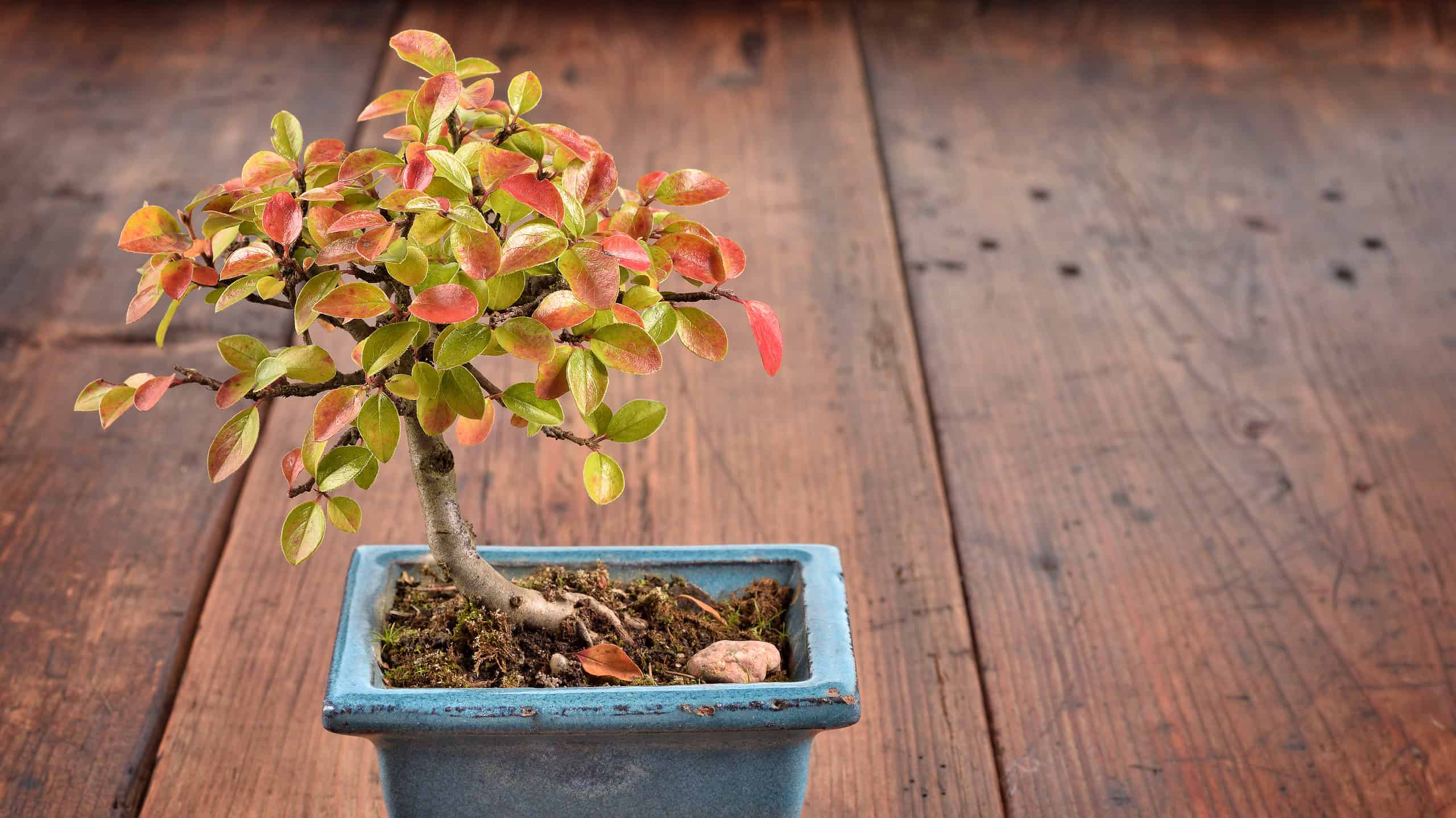Typically used as an ornamental specimen, topiary, or hedgerow, the cotoneaster tree is a choice option for the art of bonsai for many reasons, including its natural size and ease of care, making it an excellent choice for beginners. The cotoneaster is a flowering plant that has beautiful foliage as well.
Let’s take a look at this beautiful plant and learn if the cotoneaster bonsai is a good choice for your skill level and desire.
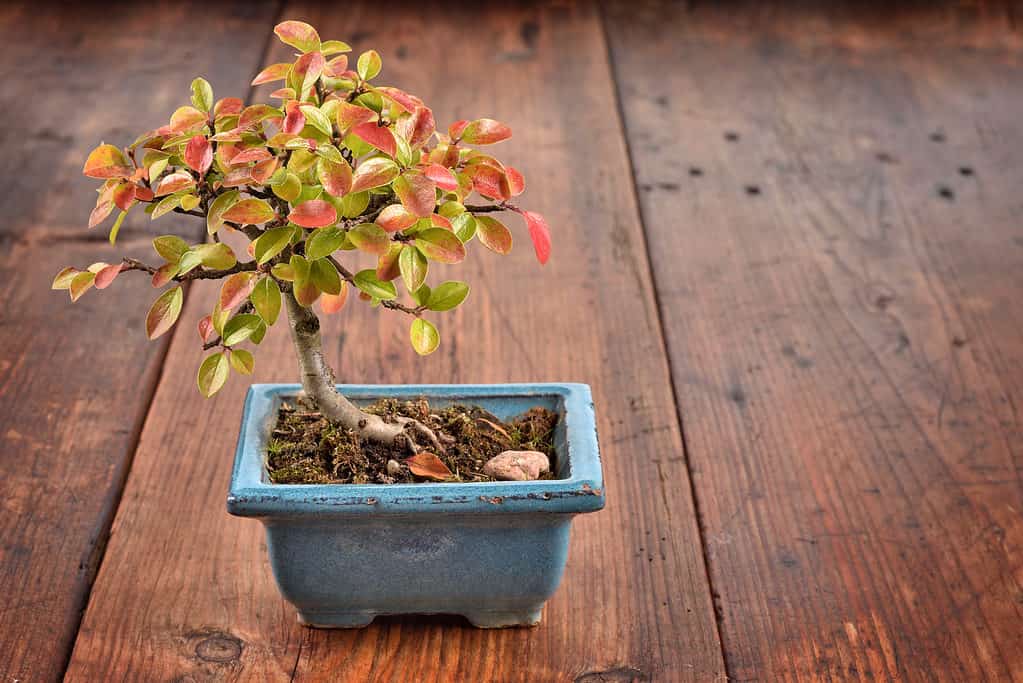
Cotoneaster bonsai may be evergreen or deciduous.
©iStock.com/Geo-grafika
What Makes Cotoneaster Good for Bonsai?
Among the cotoneasters, there are both evergreen and deciduous species. The varieties have small leaves, fruits, and flowers. They work well as bonsai in practically any style or shape and they don’t require loads of specialized care, making them excellent for beginners and busy bonsai enthusiasts who may not have loads of time to care for them.
Cotoneaster Classification
Cotoneasters are a genus in the flowering plant in the Rosaceae family, or rose family. They’re native to temperate Asia, northern Arica, and Europe. They’re related to firethorns, hawthorns, rowans, and photinias. There are anywhere from 70 and 300 different species of cotoneaster, with many microspecies or varieties, depending on what source you’re reading about the plants.
Most cotoneasters are shrubs though some are small tree species that reach up to roughly 50 feet in height.
Cotoneaster Description
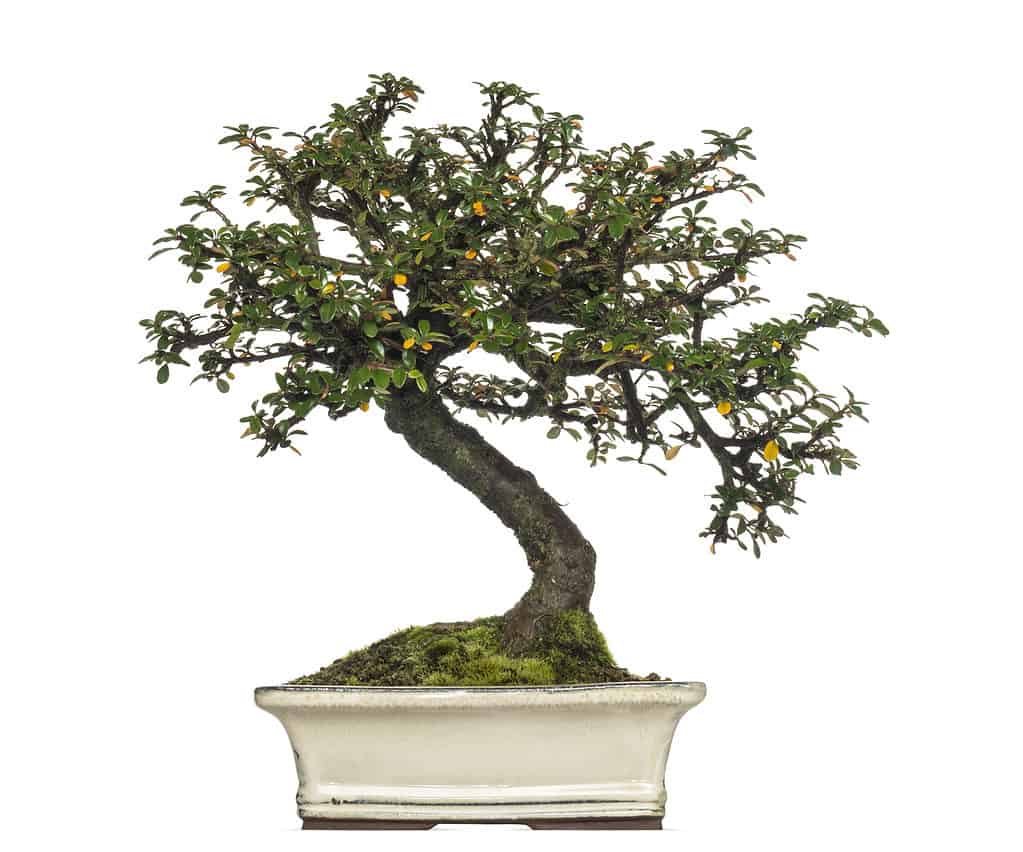
Cotoneaster bonsai may be shaped into almost any style.
©iStock.com/GlobalP
Most cotoneasters are small shrubs, though some may grow to be smaller trees. They are often used as ground-hugging ground cover, depending on the species. However, most that are used in the bonsai art form are easily shaped into trees.
Despite there being so many varieties of cotoneasters, most share the same characteristics of ovate leaves that are deep green in spring through summer and then orange or red in autumn before they fall. The branches grow in a herringbone style or pattern, which is an alternating of short branches from thicker structural branches.
In the springtime and early summer, the cotoneasters produce pale pink or white flowers and red berries, which may be on the tree in any season, depending on climate, location, and care of the bonsai.
Origins and History of Cotoneaster
The cotoneaster shrub or tree is native to the region stretching between the alpine foothills of the Himalayas to northern Africa. The region has many climates within, from alpine cold to hot and dry regions, meaning the varieties of cotoneaster found may be anywhere from extreme cold resistant to drought resistant and everything in between. This is another reason the cotoneaster is a popular choice for bonsai enthusiasts – they can handle practically anything climate wise, depending on the particular variety you choose.
Types of Cotoneaster
There are many varieties of cotoneasters, with three types of growth patterns.
Low Growing
Cotoneaster shrubs may come in short, ground-cover style shrubs that come in at under three feet in height, with some lower, not growing over eight inches from the ground. Among these, you’ll find many unique varieties, including the cranberry shrub which is cultivated for the fruit. They are sometimes grown ornamentally, though many are cultivated for the fruit to turn into juice, fresh berries for seasonal offerings, and confectionary uses. Additionally, thyme leaf cotoneaster, barberry, and rock spray are among the low growing cotoneasters.
Rounded
Growing up to 12 feet in height, rounded cotoneasters are mostly evergreen and often chosen for larger, ornamental specimens thanks to their full blossoms in springtime.
Upright
Either evergreen or deciduous, upright cotoneasters may grow up to 25 feet in height in most cases, and tend to be extremely hardy. Peking and willow leaf cotoneaster are among these, and tend to be popular for gardens thanks to their vibrant berries and foliage.
Varieties of Cotoneaster

The attractive foliage is a large draw for using cotoneaster as bonsai.
©iStock.com/photohomepage
There are several varieties of cotoneasters that are popular among bonsai enthusiasts. Some of the most popular include the following.
Cotoneaster microphyllus
The Cotoneaster microphyllus is an evergreen with dark, slender leaves and white flowers.
Cotoneaster horizontalis
Cotoneaster horizontalis is a popular choice for those creating a root over rock bonsai style. This variety is one of the easier to style and offers gorgeous glossy, dark green leaves, pink flowers, and bright orange berries. It’s often shaped into bushy styles and produces the herringbone growth pattern.
Cotoneaster adpressus praecox
For those who love vibrant colors, the cotoneaster adpressus praecox is particularly incredible in autumn when the leaves turn bright scarlet and the berries turn vivid red.
Cotoneaster conspicuus decorus
A compact variety, the Cotoneaster conspicuus decorus blooms with bright white flowers that are incredibly fragrant. It is chosen most often for the delightful aroma.
Cotoneaster skogholm
The Cotoneaster skogholm is a dwarf variety of cotoneaster that is one of the easiest to form and maintain as a cotoneaster bonsai. The tree produces tiny leaves but large (proportionately) berries.
Cotoneaster integrifolius
Cotoneaster integrifolius is also known as the wintergreen cotoneaster or entire-leaved cotoneaster. This is a low growing variety of cotoneaster and fairly easy to maintain as a bonsai.
Cotoneaster congesta
For particularly small bonsai, the Cotoneaster congesta is particularly favorable, as it is naturally a tiny shrub.
Special Notes on Cotoneaster
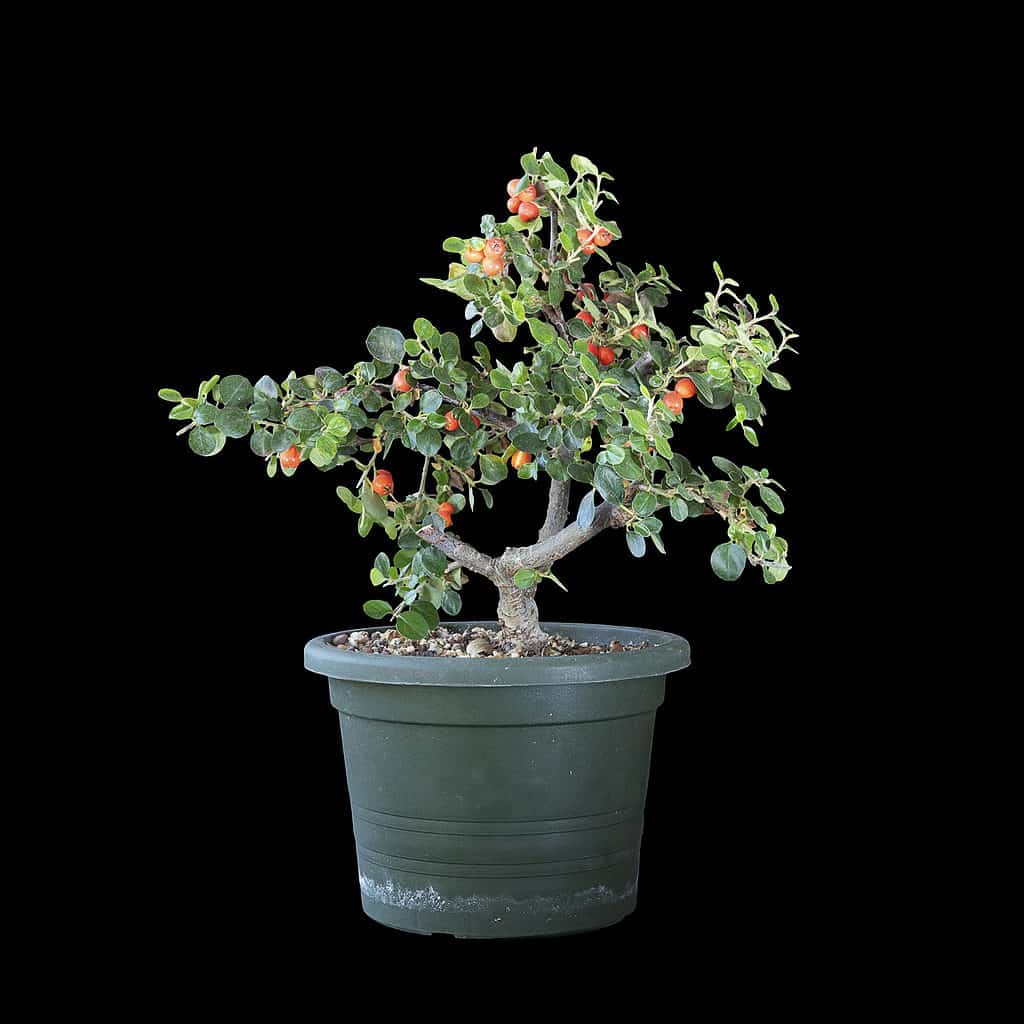
The vibrant berries stand out on the tree.
©iStock.com/taviphoto
Among some of the most favored flowering bonsai, like the lilac and the jasmine, the cotoneaster has some particular care needs to keep in mind as you grow the lovely bonsai.
How to Grow Cotoneaster Bonsai Trees
Soil Needs
One of the most important needs of the cotoneaster bonsai is the soil. The soil needs to be well-drained and allow for proper nutrient binding, while allowing the splitting and spreading of roots without derailing the health of the cotoneaster. There also needs to be plenty of circulation in the soil. Some folks also recommend using fine mesh at the bottom of the pot to keep the soil nutrients from washing away.
Container Needs
Ideally, use a bone china or clay pot in rectangular or oval shapes for your cotoneaster bonsai. The pot should be reasonably shallow, though deep enough to allow some root growth, the mesh at the bottom, and enough of the healthy soil to grow the bonsai. The pot should be approximately the same as the thickest part of the trunk. Too deep a pot will prevent the bonsai effect and produce a larger tree.
Planting Location
Most species of cotoneaster do better in direct, full sunlight. However, they do need partial shade during the hottest months. They should also be placed somewhere that they are protected from frost. They should be kept outdoors mostly and brought in to avoid the coldest and hottest days of the year if temperatures in your climate exceed those as recommended. They also need to be protected from strong wind.
Many opt to keep the tree in an unheated garage or shed or in a cold greenhouse.
Lighting
Cotoneaster bonsai thrive in full, direct sunlight, with shade in the hottest months of the year.
Temperature
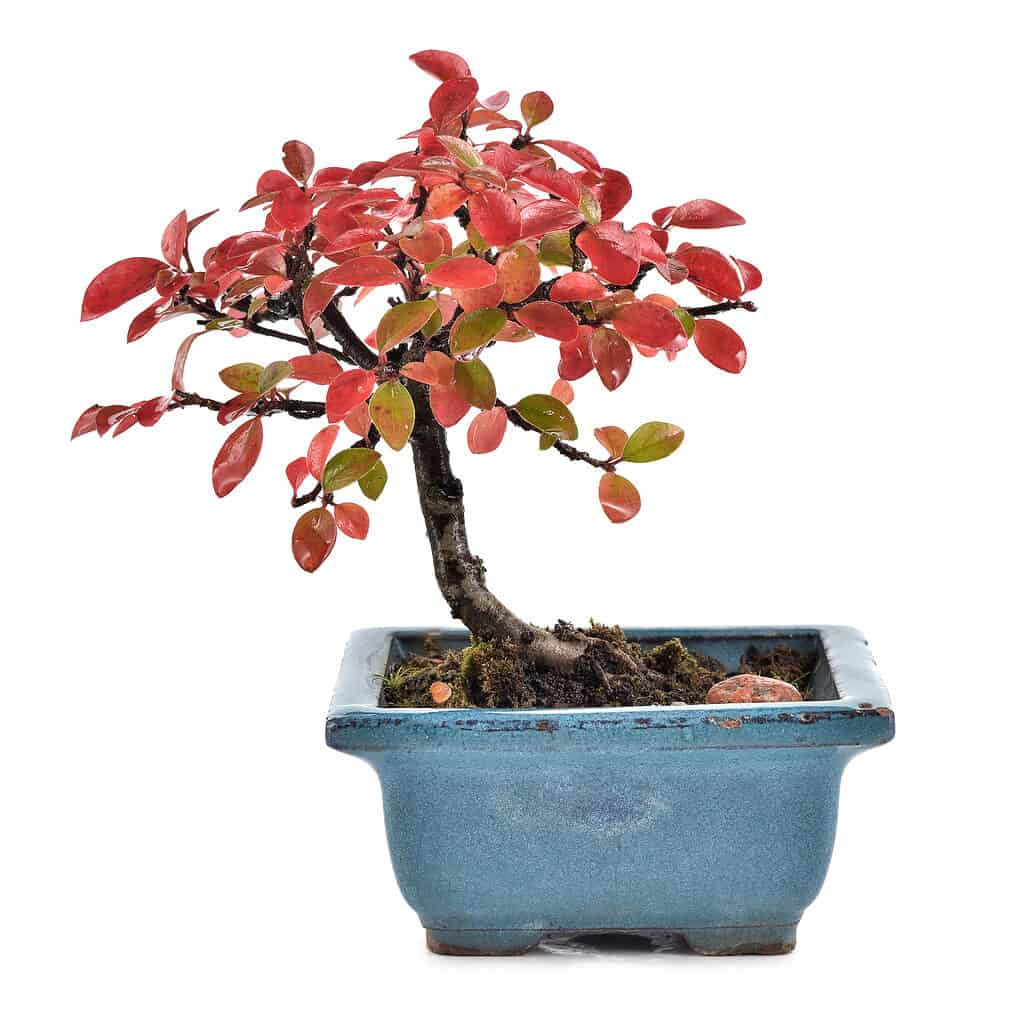
The cotoneaster bonsai leaves may turn vibrant red or orange in autumn.
©iStock.com/Geo-grafika
Cotoneaster bonsai should be kept in spaces that are above 45 degrees F year-round, though they may tolerate frost. If you receive plenty of frost or hard cold winter temperatures, it’s recommended that you keep the cotoneaster in a cool greenhouse or unheated garage instead of leaving it outdoors.
Watering
Cotoneaster bonsai require plenty of water, particularly in summertime and heat waves. They can technically survive droughts, but shouldn’t be allowed to get and stay dry for long. Cotoneasters can come back from dry spells, though, even if leaves have fallen off due to drought. Restore the plant with water, keeping the soil slightly moist. In cooler months, the cotoneaster bonsai also requires fair waterings, keeping the soil lightly moist. As the temperatures drop, move the plant indoors or avoid overly moist soil when the cold hits.
Avoid over watering, though, as this may cause root rot.
Feeding
Liquid fertilizer every week for the cotoneaster bonsai is a good rule of thumb, or a monthly application of a solid organic fertilizer. The ideal fertilizer is balanced with enough potassium, micronutrients, and phosphorous for plenty of fruit and flowers. Once the flowers start to appear, only fertilize with a general fertilizer and a non-nitrogen fertilizer as the growing season progresses.
Reduce feeding in winter to every other month or follow the instructions if it’s a bonsai fertilizer.
Pruning, Wiring, and Shaping
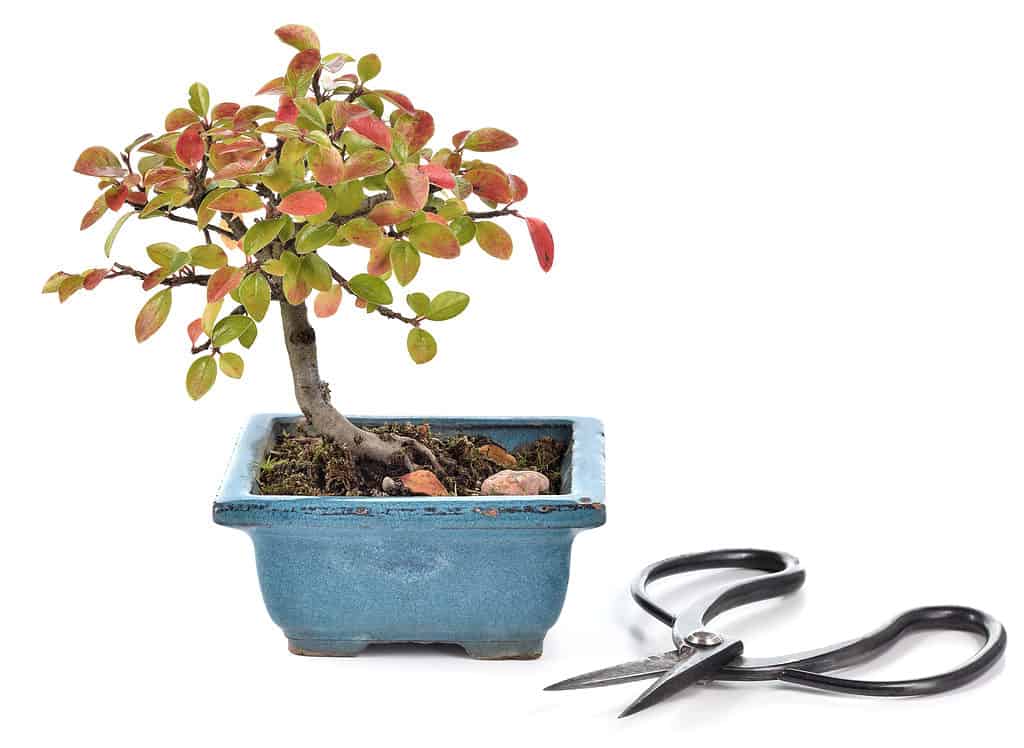
Cotoneaster bonsai isolated on white background, shears in foreground
©iStock.com/Geo-grafika
The most common bonsai styles most often used for cotoneaster bonsai include root over rock, exposed root, clasped to rock, clump growth, multi-trunk, informal upright, twin trunk, semi-cascade, cascade, and slanting. The genera does well with near constant pruning in the evergreen varieties, with older branches being pruned in spring and young shoots trimmed during the growing season.
Using aluminum wire, at least seven months after growth, you can wire cotoneasters any time of the year, focusing on the younger branches, which are more flexible. The older branches will be stiff, even brittle, and may break off if you wire them too harshly. As you wire, sense the texture of the branches. If they seem brittle, move along to other branches. If they are at least somewhat supple, use guy wires to shape them.
Re-potting
Younger trees should be re-potted early in spring every year. Older deciduous cotoneaster bonsai trees should be re-potted every 2 to 3 years, also in springtime as the tree comes out of dormancy, with considerable root pruning, up to 60%. When re-potting, any cotoneaster needs to be planted in fresh, new potting soil that is well-drained. The evergreen varieties will need to be re-potted less frequently, usually every 4 to 5 years.
The sign that it’s time for re-potting is generally unhealthy-looking growth (or lack thereof) and lack of blooming.
Common Problems of Cotoneasters
There are several common issues that may plague your cotoneaster bonsai. Most have fairly simple solutions, though.
Powdery Mildew, Root Rot, Bacterial Blight
Some of the more common issues for the cotoneaster bonsai are those that are borne of over watering issues. Powdery mildew, root rot, bacterial blight, and similar water-borne issues may easily arise for cotoneasters. The reason being that watering can be a tricky piece with cotoneasters. They can survive in mild drought conditions though high humidity, but they cannot handle being over watered. Unfortunately, this happens frequently until the enthusiast finds the right level of moisture. Keeping the soil lightly moist, not wet, is the proper water level for the plants.
Correcting the water and sunlight position is your first step to correcting this issue. Follow this by using a gentle fungicide. Follow the instructions as the package directs.
Aphids, Scale, Caterpillars, Borers, Spider Mites
Additionally, cotoneasters may have issues with scale, spider mites, and other insect infestations.
Scale presents in the form of brown or black bumps on the stems and branches of the cotoneaster.
Spider mites manifest in tiny white or yellow spots on top of the leaves, silky webs woven around the stem and leaves, and/or a yellow or bronze tinge that overcomes the tree.
Aphids appear as tiny, dark spots beneath the leaves of the plant.
To deal with these, caterpillars, borers, and other infestations, use a gentle, organic pesticide soap or spray to treat. Ensure that you do not use the pesticide on moist soil. Wait for the soil to dry out first before applying.
After treatment, gently remove scale, spider mites, caterpillars, and others by hand. Then let the plant dry completely, re-examine for anything residual, remove anything you find, and then wipe away all traces with rubbing alcohol.
How to Propagate Cotoneaster Bonsai Trees
There are two primary ways to propagate cotoneaster bonsai: cuttings and seeds. Technically, air-layering is also popular, though much more challenging.
Growing Cotoneaster Bonsai from Seeds
In the springtime, cotoneaster may be propagated from seeds. It takes longer via seeds, of course, than from cuttings. For this reason, most folks prefer growing from soft wood cuttings.
If you do choose to grow from seeds, there aren’t any particular special notes on growing them.
Growing Cotoneaster Bonsai from Cuttings
In early summer, soft cuttings may be taken and grown from a mother cotoneaster tree. Once you take the cuttings, dip the cut ends into rooting hormone and put them in a well-draining growing medium. Suggestions include akadama or perlite.
Mist the foliage regularly to keep the cuttings moist but only water the soil when it is dry to the touch. When the plant takes root, it is ready to transfer into the pot in which you plan to grow the cotoneaster bonsai.
Cotoneaster Bonsai FAQs

Cotoneaster berries are typically vibrant orange or red.
©iStock.com/Wirestock
Can you grow cotoneaster bonsai outdoors?
It’s actually recommended that you grow your cotoneaster outdoors, save in wintertime when it consistently hits below 45 degrees F.
How long does it take for a cotoneaster bonsai to grow?
Standard cotoneaster trees take between three and four years to reach maturity. Cotoneaster bonsai, however, take a bit longer, often up to five years.
How frequently should I prune cotoneaster bonsai?
Cotoneaster bonsai should be pruned fairly frequently throughout the growing season and beyond. The evergreen varieties, in particular, should be trimmed reasonably often.
Are cotoneaster berries edible?
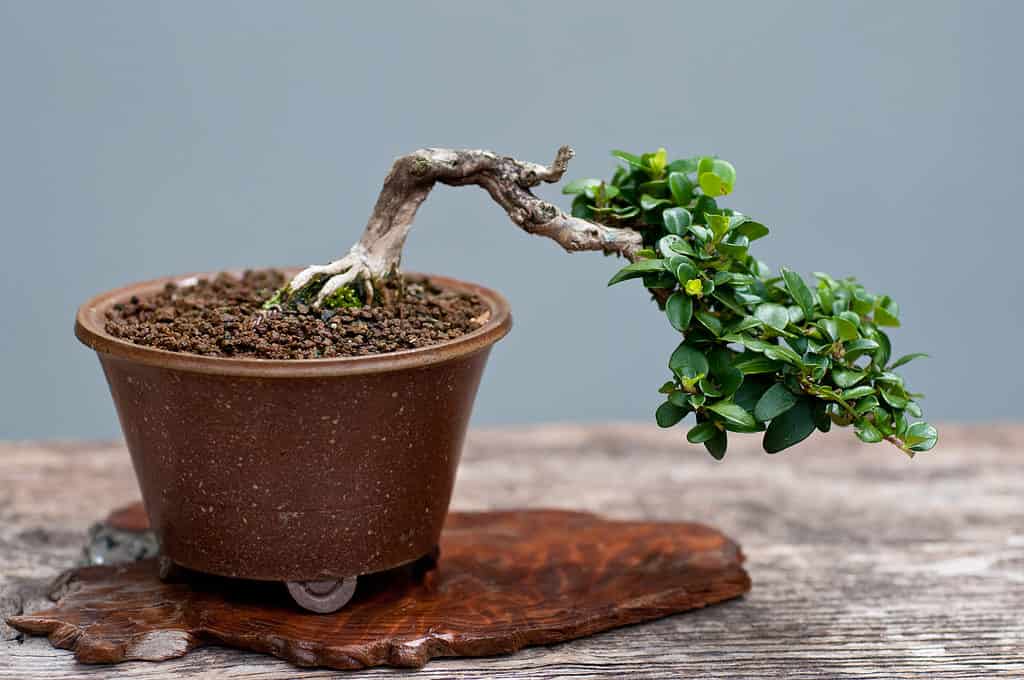
Cotoneaster bonsai are trained in many shapes and styles.
©iStock.com/photohomepage
Depending on the species of cotoneaster, some of the berries are edible (cranberries, for example), but many can cause some mild to moderate stomach pain. Larger quantities of the wrong varieties will actually be moderately toxic, making someone ill enough for medical attention.
Are cotoneaster likely to lose their leaves?
Some varieties of cotoneaster bonsai are deciduous, meaning they will lose their leaves in autumn. Other varieties are evergreen and will keep their leaves year-round, unless exposed to harsh temperatures or other unfavorable growing conditions.
Do cotoneaster bonsai have thorns?
Cotoneaster bonsai do not have thorns.
Up Next:
Thank you for reading! Have some feedback for us? Contact the AZ Animals editorial team.

